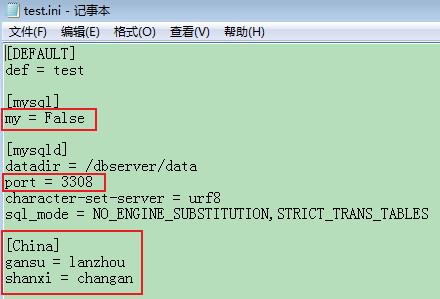第十七天python3 文件IO
Posted 潇湘神剑
tags:
篇首语:本文由小常识网(cha138.com)小编为大家整理,主要介绍了第十七天python3 文件IO相关的知识,希望对你有一定的参考价值。
CSV文件
csv是一个被行分隔符、列分隔符化分成行和列的文本文件;
csv不指定字符编码;
行分隔符为\\r\\n,最后一行可以没有换行符;
列分隔符常为逗号或者制表符;
每一行称为一条记录record
字段可以使用双引号括起来,也可以不使用;如果字段中出现了双引号、逗号、换行符必须使用双引号括起来。如果字段的值是双引号,使用两个双引号表示一个转义,表头可选,和字段列对齐即可;
from pathlib import Path csv_body = """\\ id,name,age,comment 1,zhang,18,"I`m 18" 2,wang,20,"Hello BeiJing" 3,li,23,"你好,计算机" """ p = Path(\'C:/Users/Sunjingxue/Downloads/test.csv\') p.parent.mkdir(parents=True,exist_ok=True) p.write_text(csv_body)

reader() 读取csv文件内容
import csv csvname = "C:/Users/Sunjingxue/Downloads/test.csv" with open(csvname) as f: red = csv.reader(f) print(red) #返回一个csv对象 for row in red: #print(row) 返回一个列表 print(\', \'.join(row)) #返回结果 <_csv.reader object at 0x0000000001E2BC40> id, name, age, comment 1, zhang, 18, I`m 18 2, wang, 20, Hello BeiJing 3, li, 23, 你好,计算机
#在python3.5.2环境下 In [1]: from pathlib import Path In [2]: import csv In [3]: p = Path(\'/root/test.csv\') In [4]: with open(p) as f: #此时如果不将p转换成字符串类型,运行时会报错; ...: red = csv.reader(f) ...: for i in red: ...: print(i) ...: --------------------------------------------------------------------------- TypeError Traceback (most recent call last) <ipython-input-4-5e013681f47a> in <module> ----> 1 with open(p) as f: 2 red = csv.reader(f) 3 for i in red: 4 print(i) 5 TypeError: invalid file: PosixPath(\'/root/test.csv\') In [5]: with open(str(p)) as f: ...: red = csv.reader(f) ...: for i in red: ...: print(i) ...: [\'1\', \'zhang\', \'18\'] [\'2\', \'wang\', \'19\'] [\'3\', \'li\', \'20\']
#在python3.8.6环境下 from pathlib import Path import csv p = Path("C:/Users/Sunjingxue/Downloads/test.csv") print(type(p)) with open(p) as f: #在3.8.6环境下则不需要将p转换成字符串类型; re = csv.reader(f) for i in re: print(\', \'.join(i)) #并且re还是个生成器;可以用next()读取;print(next(re))
writer(csvfile,dialect=\'execl\',**fmtparams) 返回DictWriter的实例
主要的方法有:
writerow() 读取1行
writerows() 读取多行
from pathlib import Path import csv rows = [[4,\'tom\',22,\'banana\'], (5,\'jerry\',24,\'apple\'), (6,\'lilei\',25,\'just\\t"in\'), \'abcdefg\', ((\'one\',\'two\'),(\'three\',\'four\')) ] row = [\'序号\',\'姓名\',\'年龄\',\'别名\'] p = Path(\'C:/Users/Sunjingxue/Downloads/test.csv\') with open(p,\'w\',newline=\'\') as f: wr = csv.writer(f) wr.writerow(row) wr.writerows(rows)

从上面的例子可以看出,写入csv文件列表中的元素可以是列表,元组,字符串;在open()的时候,newline=‘ ’,如果不对换行符做处理,则每写一行就会加一行空白行(windows默认是\\r\\n),非常的影响观感;
ini文件处理
中括号里面的部分程为section,译作节、区、段;
每个section内,都是key=value形成的键值对,key称为option选项;
注意:这里的DEFAULT是缺省section的名字,必须大写;
#示例ini文件
[DEFAULT] def = test [mysql] my = True [mysqld] datadir = /dbserver/data port = 3306 character-set-server = urf8 sql_mode = NO_ENGINE_SUBSTITUTION,STRICT_TRANS_TABLES
configparser模块
可以将section当做key,section存储这键值对组成的字典,可以把ini配置文件当做一个嵌套的字典,默认使用的是有序字典;
read(filenames,encoding=None) 读取ini文件,可以是单个文件,也可以是文件列表,可以指定文件编码;
sections() 返回section列表,缺省section不包括在内;
options(section) 返回section的所有option,会追加缺省的section的option;
has_option(section,options) 判断section是否存在这个option;
get(section,option,*,raw=False,vars=None[,fallback]) 从指定的段的选项上取值,如果找到返回,如果没有找到就去找DEFAULT端有没有;
getint(section,option,*,raw=False,vars=None[,fallback])
getfloat(section,option,*,raw=False,vars=None[,fallback])
getboolean(section,option,*,raw=False,vars=None[,fallback])
上面3个方法和get一样,返回指定类型数据;
from configparser import ConfigParser filename = \'C:/Users/Sunjingxue/Downloads/test.ini\' cfg = ConfigParser() cfg.read(filename) #打印所有section,不包括默认section; print(cfg.sections()) #打印section的所有options,并且会追加默认section的option; print(cfg.options(\'mysqld\')) #判断指定section中的指定option是否存在 print(cfg.has_option(\'mysqld\',\'port\')) #判断section是否存在; print(cfg.has_section(\'client\')) #从指定的section中取指定的option的值,如果不存在则去DEFAULT找,如果DEFAULT中没有则报错 print(cfg.get(\'mysqld\',\'port\')) print(cfg.get(\'mysqld\',\'def\')) #返回int类型的数值 print(cfg.getint(\'mysqld\',\'port\')) #返回float类型的数值 print(cfg.getfloat(\'mysqld\',\'port\')) #返回布尔值类型的数值 print(cfg.getboolean(\'mysql\',\'my\')) #如果指定了section,则返回该section名和option,组成二元组;如果不指定seciton,则返回所有section的类; ####################### 返回结果: [\'mysql\', \'mysqld\', \'China\'] [\'datadir\', \'port\', \'character-set-server\', \'sql_mode\', \'def\'] True False 3306 test 3306 3306.0 True
items(raw=False,vars=None)
items(section,raw=False,vars=None)
没有section,则返回所有section名字及其对象,如果指定section,则返回这个指定的section的键值对组成二元组;
#如果指定了section,则返回该section名和option,组成二元组;如果不指定seciton,则返回所有section的类; print(cfg.items(\'mysql\')) print(cfg.items()) for k,v in cfg.items(): print(k,type(v)) print(k,cfg.items(k)) #执行结果 [(\'def\', \'test\'), (\'my\', \'True\')] ItemsView(<configparser.ConfigParser object at 0x0000000001DF8FD0>) DEFAULT <class \'configparser.SectionProxy\'> DEFAULT [(\'def\', \'test\')] mysql <class \'configparser.SectionProxy\'> mysql [(\'def\', \'test\'), (\'my\', \'True\')] mysqld <class \'configparser.SectionProxy\'> mysqld [(\'def\', \'test\'), (\'datadir\', \'/dbserver/data\'), (\'port\', \'3306\'), (\'character-set-server\', \'urf8\'), (\'sql_mode\', \'NO_ENGINE_SUBSTITUTION,STRICT_TRANS_TABLES\')] China <class \'configparser.SectionProxy\'> China [(\'def\', \'test\'), (\'gansu\', \'lanzhou\'), (\'shanxi\', \'changan\')]
add_section(section_name) 增加一个section;
set(section,option,value)
section存在的情况下,写入option=value,要求option、value必须是字符串;
remove_section(section) 移除section及其所有option;
remove_section(section,option) 移除section下的option;
write(fileobject,spece_around_delimiters=True) 将当前config的所有内容写入fileobject中,一般open函数使用w模式;
if cfg.has_section(\'China\') == True: pass else: cfg.add_section(\'China\') with open(filename,\'w\') as f: cfg.set(\'China\', \'gansu\', \'lanzhou\') cfg.set(\'China\', \'shanxi\', \'changan\') cfg.write(f)
#通过字典操作修改ini文件中的值; #cfg[\'section\'][\'option\'] = \'value\' #cfg[\'section\'] = {\'option\' = \'value\'} cfg[\'mysqld\'][\'port\'] = \'3308\' cfg[\'mysql\'] = {\'my\':\'False\'} #修改完成之后写入文件 with open(filename,\'w\') as f: cfg.write(f)
执行结果:

以上是关于第十七天python3 文件IO的主要内容,如果未能解决你的问题,请参考以下文章